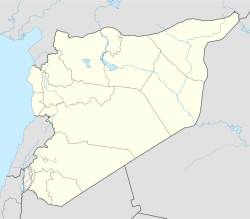Al-Mushannaf
Al-Mushannaf
المشنف | |
|---|---|
Town | |
| Coordinates: 32°44′34″N 36°46′28″E / 32.74278°N 36.77444°E | |
| Country | |
| Governorate | Suwayda |
| District | Suwayda |
| Subdistrict | Mushannaf |
| Elevation | 1,400 m (4,600 ft) |
| Population (2004 census)[1] | |
• Total | 2,581 |
| Time zone | UTC+2 (EET) |
| • Summer (DST) | UTC+3 (EEST) |
Al-Mushannaf (Arabic: المشنف also spelled Mushennef) is a village in southern Syria, administratively part of the al-Suwayda Governorate, located northeast of al-Suwayda. Nearby localities include Tarba to the north, Shahba and Salkhad to the northwest, Qanawat to the west and al-Kafr to the southwest. According to the Syria Central Bureau of Statistics (CBS), al-Mushannaf had a population of 2,581 in the 2004 census. The town is also the administrative center of the al-Mushannaf nahiyah of the al-Suwayda District consisting of 14 villages with a combined population of 17,134.[1]
History
[edit]Al-Mushannaf (ancient Nela or Nelkomia) was a part of the province of Syria under the Roman Empire on the borders with the province of Arabia Petraea.[2]
Druze tribes settled in the village between 1856 and 1858.[3]
Roman-period temple
[edit]
The village has a well preserved Roman prostyle temple dating to the first century BC that was dedicated to the gods Zeus and Athena.[4][5] The temple stands on a podium, measuring 13.45 by 9.6 metres (44.1 ft × 31.5 ft),[6] and faces a rectangular temenos which is surrounded by four walls and looks out on an artificial pool from its south side and colonnades on the other ones. The temple's entrance is aligned to the north and the courtyard has steps that lead to the inner sanctuary.[7] The whole temple is built from the local black basalt rocks.[6] The walls are built without binding materials and display beautiful ornaments including capitals and entablature,[7] while the courtyard is paved with flat stones of various sizes.[6] An inscription inside the temple states that it was built in celebration of the Herodian king Agrippa I.[5] The temple was excavated in the early 1900s by Howard Crosby Butler and later by Clarence Ward, and was partially restored by the Syrian government.[7]
See also
[edit]References
[edit]Bibliography
[edit]- Ball, W. (2002). Rome in the East. Routledge. ISBN 9780415243575.
- Bowersock, G. (1994). Roman Arabia. Harvard University Press. ISBN 9780674777569.
- Firro, Kais (1992). A History of the Druzes, Volume 1. BRILL. ISBN 9789004094376.
- Kaizer, Ted (2008). The Variety of Local Religious Life in the Near East In the Hellenistic and Roman Periods. BRILL. ISBN 9789004167353.
- Shahîd, I. (1995). Byzantium and the Arabs in the Sixth Century: Ecclesiastical history, Volumes 1-2. Dumbarton Oaks. ISBN 9780884022145.
- Ward, Clarence (1907). "The Temple at Mushennef, Haurân, Syria". American Journal of Archaeology. 11 (1). Archaeological Institute of America: 1–6. doi:10.2307/497031. JSTOR 497031.
External links
[edit]- Map of the town, Google Maps
